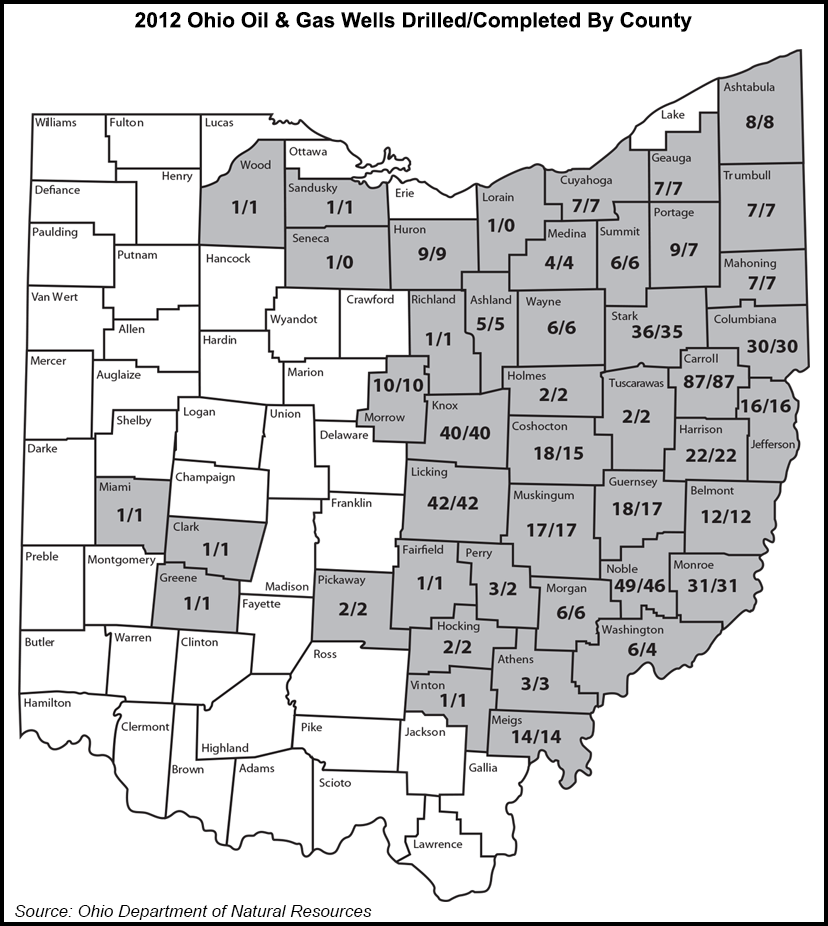Utica Shale | E&P | NGI All News Access | NGI The Weekly Gas Market Report
Utica Activity in 2012 Boosts Ohio’s Oil, Gas Industry
A report released late Tuesday by the Ohio Department of Natural Resources (ODNR) appears to show how much shale exploration in the Utica/Point Pleasant formation lifted the state’s historic oil and gas industry in 2012.

Released annually for the last 48 years, The Ohio Oil and Gas Summary is otherwise known as the McCormac Report for author Mike McCormac, who retired as ODNR’s oil and gas permitting manager in December. The report serves as a compendium of sorts that details permitting activity, production reports, as well as conventional and unconventional exploration.
According to the latest issue, Ohio in 2012 issued 1,825 permits to convert, deepen, drill, plug and abandon vertical, horizontal and directional wells, up by 292 permits, or 19%, compared with 2011.
There were 198 wells drilled into the Utica/Point Pleasant formations in 2012. Over the period, ODNR’s Division of Oil and Gas Resources Management issued 459 drilling permits. In all, Utica/Point Pleasant permits accounted for slightly more than half (51%) of all the drilling permits issued and 36% of all the wells drilled in Ohio last year.
Since Ohio’s first commercial oil production began in 1860, the state like many others has seen its energy fortunes rise and fall. Not since the Morrow County oil boom of 1963, or rising oil and gas prices and greater local demand in the 1970s set the state’s industry up for a fall when those prices collapsed in 1986, has oil and gas been at the leading edge of the state’s economy.
Not included in Tuesday’s report is the sharp increase in permitting and drilling activity since 2012. Through Saturday (Nov. 16), 988 horizontal permits had been issued and 606 wells drilled in 2013, according to current ODNR records (see Shale Daily, Nov.19).
Last year’s production numbers were relatively favorable as well, according to the report. Ohio produced more than 4.9 million bbl of crude oil and 86 Bcf of natural gas, for a combined 2012 market value of more than $706 million.
ODNR issued production reports for 85 Utica/Point Pleasant wells in 2012, of which 63 were commercial producing wells, with 19 tested and shut-in and three dry (see Shale Daily, May 17). At the time, those wells produced 635,000 bbl and 12.8 Bcf — numbers that had some skeptical of the play’s potential. However, that figure is expected to improve when ODNR reports results again this year, as more wells have come online and as more operators issue results.
The report also found that Upper Devonian permits increased in 2012 by 11 for a total of 65, including seven issued for the Marcellus Shale in Ohio. Devonian permits accounted for 7% of all those issued for drilling, a number that also is expected to rise as more operators target the formation, a mix of organic-rich shale and sandstone rock above the Marcellus, which presents a stack of targets in some parts of the play.
© 2024 Natural Gas Intelligence. All rights reserved.
ISSN © 2577-9877 | ISSN © 1532-1266 | ISSN © 2158-8023 |
